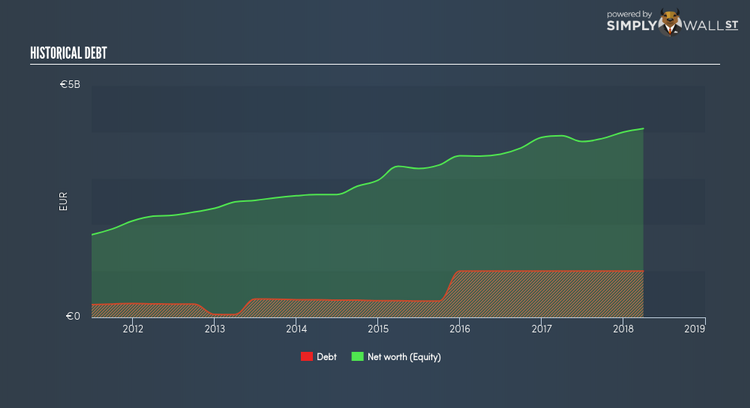Dassault Systèmes SE (EPA:DSY): Time For A Financial Health Check

Investors pursuing a solid, dependable stock investment can often be led to Dassault Systèmes SE (ENXTPA:DSY), a large-cap worth €28.56B. Risk-averse investors who are attracted to diversified streams of revenue and strong capital returns tend to seek out these large companies. However, the key to extending previous success is in the health of the company’s financials. Today we will look at Dassault Systèmes’s financial liquidity and debt levels, which are strong indicators for whether the company can weather economic downturns or fund strategic acquisitions for future growth. Note that this commentary is very high-level and solely focused on financial health, so I suggest you dig deeper yourself into DSY here. Check out our latest analysis for Dassault Systèmes
How much cash does DSY generate through its operations?
DSY’s debt level has been constant at around €1.00B over the previous year – this includes both the current and long-term debt. At this stable level of debt, DSY currently has €2.46B remaining in cash and short-term investments for investing into the business. On top of this, DSY has produced cash from operations of €745.02M in the last twelve months, leading to an operating cash to total debt ratio of 74.50%, meaning that DSY’s current level of operating cash is high enough to cover debt. This ratio can also be interpreted as a measure of efficiency as an alternative to return on assets. In DSY’s case, it is able to generate 0.75x cash from its debt capital.
Can DSY meet its short-term obligations with the cash in hand?
With current liabilities at €1.53B, it appears that the company has maintained a safe level of current assets to meet its obligations, with the current ratio last standing at 2.36x. Generally, for Software companies, this is a reasonable ratio since there is a bit of a cash buffer without leaving too much capital in a low-return environment.
Can DSY service its debt comfortably?
With debt at 24.54% of equity, DSY may be thought of as appropriately levered. DSY is not taking on too much debt commitment, which can be restrictive and risky for equity-holders.
Next Steps:
DSY’s high cash coverage and appropriate debt levels indicate its ability to utilise its borrowings efficiently in order to generate ample cash flow. Furthermore, the company exhibits an ability to meet its near-term obligations, which isn’t a big surprise for a large-cap. I admit this is a fairly basic analysis for DSY’s financial health. Other important fundamentals need to be considered alongside. I recommend you continue to research Dassault Systèmes to get a better picture of the stock by looking at:
Future Outlook: What are well-informed industry analysts predicting for DSY’s future growth? Take a look at our free research report of analyst consensus for DSY’s outlook.
Valuation: What is DSY worth today? Is the stock undervalued, even when its growth outlook is factored into its intrinsic value? The intrinsic value infographic in our free research report helps visualize whether DSY is currently mispriced by the market.
Other High-Performing Stocks: Are there other stocks that provide better prospects with proven track records? Explore our free list of these great stocks here.
To help readers see pass the short term volatility of the financial market, we aim to bring you a long-term focused research analysis purely driven by fundamental data. Note that our analysis does not factor in the latest price sensitive company announcements.
The author is an independent contributor and at the time of publication had no position in the stocks mentioned.

 Yahoo Finance
Yahoo Finance 
